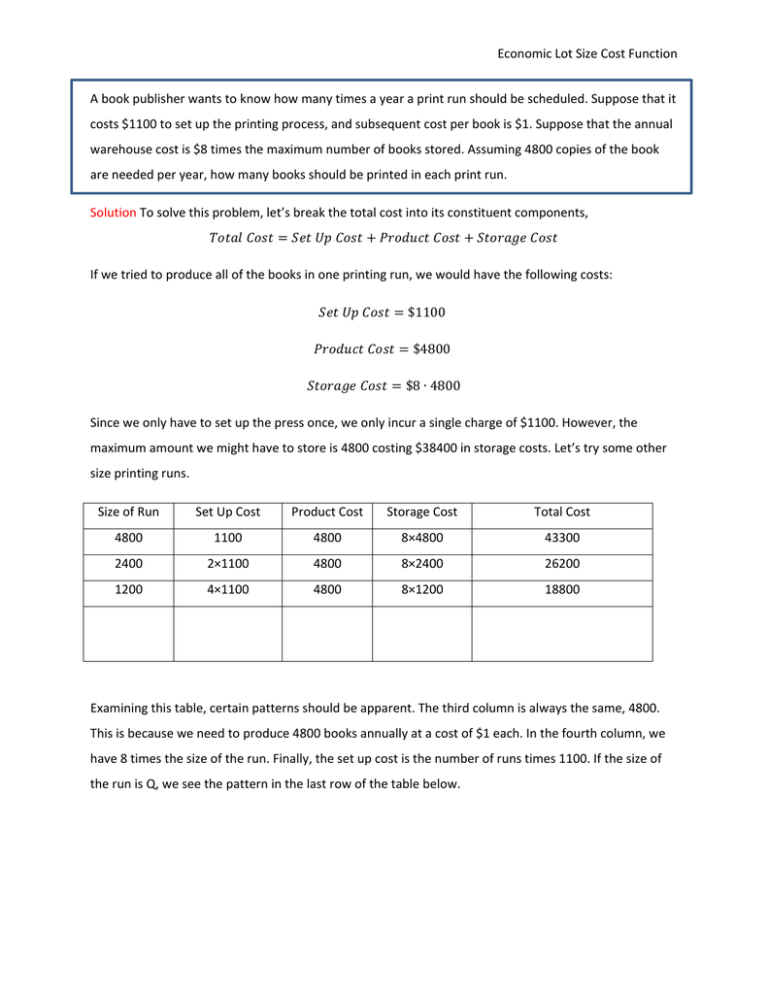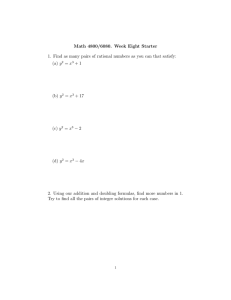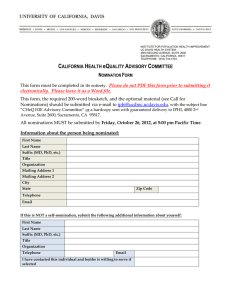Economic Lot Size Cost Function A book publisher wants to know
advertisement

Economic Lot Size Cost Function A book publisher wants to know how many times a year a print run should be scheduled. Suppose that it costs $1100 to set up the printing process, and subsequent cost per book is $1. Suppose that the annual warehouse cost is $8 times the maximum number of books stored. Assuming 4800 copies of the book are needed per year, how many books should be printed in each print run. Solution To solve this problem, let’s break the total cost into its constituent components, If we tried to produce all of the books in one printing run, we would have the following costs: $1100 $4800 $8 ∙ 4800 Since we only have to set up the press once, we only incur a single charge of $1100. However, the maximum amount we might have to store is 4800 costing $38400 in storage costs. Let’s try some other size printing runs. Size of Run Set Up Cost Product Cost Storage Cost Total Cost 4800 1100 4800 8×4800 43300 2400 2×1100 4800 8×2400 26200 1200 4×1100 4800 8×1200 18800 Examining this table, certain patterns should be apparent. The third column is always the same, 4800. This is because we need to produce 4800 books annually at a cost of $1 each. In the fourth column, we have 8 times the size of the run. Finally, the set up cost is the number of runs times 1100. If the size of the run is Q, we see the pattern in the last row of the table below. Economic Lot Size Cost Function Size of Run Set Up Cost Product Cost Storage Cost Total Cost 4800 1100 4800 8×4800 43300 2400 2×1100 4800 8×2400 26200 1200 4×1100 4800 8×1200 18800 4800 8Q Q 4800 1100 4800 1100 4800 8 Using this pattern, the total cost function is 4800 1100 4800 8 To find the minimum production run, we need to minimize this function using the derivative. This is best done by simplifying the function first, 4800 5280000 8 The derivative is 5280000 8 5280000 8 To find the critical numbers, we need to find where this function is undefined or equal to zero. Because of the denominator, it is undefined at 0. Since this is not a useable size for a print run, disregard this value. The derivative is equal to zero when 5280000 5280000 8 ∙ 8∙ 5280000 8 8 0 5280000 660000 0∙ 0 Economic Lot Size Cost Function This means the critical number is at √660000 812.4. This critical number could be a maximum or a minimum. To check, let’s check the concavity of TC at the critical number. The second derivative of TC is " 10560000 10560000 If we evaluate the second derivative at the critical number, " 812.4 10560000 812.4 0 Since the second derivative is positive, the function must be concave up at the critical point so a print run of 812.4 minimizes the total cost. In reality, we would have to average this number in the print runs since we can’t actuially print 0.4 of a book.



